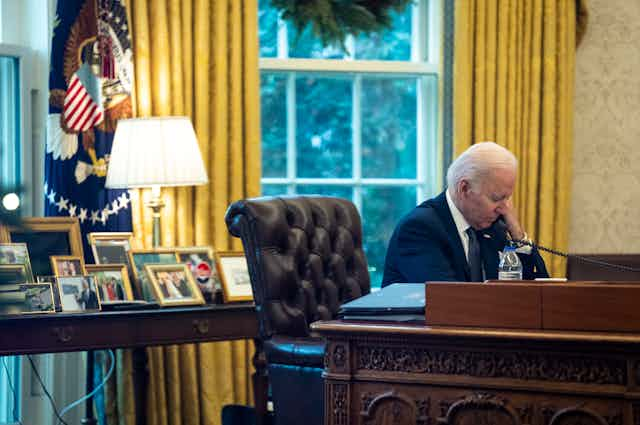When Joe Biden was sworn in as the 46th US president in January 2021, 51.3% of American voters heaved a sigh of relief – along with much of the world. After four tumultuous and unscripted years of Donald Trump, restoration of calm via his experienced successor seemed welcome. And if Biden was known for a propensity to sometimes misspeak, it seemed little more than a quaint shortcoming, certainly compared with the previous occupant of the White House.
Fast forward to the first anniversary of the Biden administration, and international news headlines shout otherwise. Speaking on January 19 about the highly volatile situation in Ukraine, Biden referred to how America and allies might respond to a “minor incursion” by Russia. Both the president and his press secretary moved quickly to make a clarification, if not fully successfully, to clean up the fallout. A disunited western response to Russian aggression is not a diplomatic win for the administration.
Nor was the chaotic US departure from Afghanistan in August 2021. Long since planned, this move had the support of the voting public but the mishandling was both a humanitarian and PR disaster, and a political blow to the administration and to US primacy in the region. The grave consequences for Afghanistan are ongoing.

Other domestic challenges, notably rising inflation, have added to popular discontent. Furthermore, the administration has been stymied in its efforts to get Congress to enact the so-called Build Back Better and Voting Rights legislation.
In both cases the frustration is exacerbated by the fact that action has been thwarted because of the decisions of two Democratic Senators. The president’s Republican opponents, meanwhile, rejoice at his stalled agenda.
Hence, drawing a negative conclusion on this busy and difficult year seems reasonable. And yet, there has been progress and amidst the prevailing “peril”, there is promise. In fact, there are numerous good news stories and accomplishments by the administration which can get lost in the media vortex. The president has not excelled at accentuating these positives, something crucial to get right in this age of hyper-scrutiny.
On the plus side
So, what positives can be included on the Biden report card? Team Biden arrived at the White House with a 200-page plan to “beat” COVID-19. The delta and omicron variants complicated this picture and dealing with an evolving virus in a nation awash with fake news was always going to be fraught.
Nonetheless, 500 million vaccines were administered during Biden’s first year in office leading to 75% of US adults receiving at least one dose. While the administration cannot be blamed for slow take-up by those who have fallen prey to misinformation, its efforts effectively to force vaccinations on large companies were rebuked by the supreme court.

Crucially, the economic story is not just about inflation (which in any case is the Federal Reserve’s primary responsibility). Between January and December 2021, the unemployment rate fell from 6.3% to 3.9% and a record 6.4 million jobs have been added to the economy. This points to a sustained recovery. Such a good news story could be of benefit to the Democrat party and at least limit the electoral damage as they head towards what may be bruising mid-term elections later in 2021.
The need to ‘cut through’
So, whether it’s the economy or the pandemic which dominates voter priorities in November, there is a positive story to tell. The president himself acknowledged in his one-year speech that he needs to “get out of this place more often” and engage with the public.
He also has some other successes, which voters clearly approved of, not least legislative accomplishment in the shape of the US$1.9 trillion (£1.4 trillion) American Rescue Plan. There are further aspects of the Build Back Better agenda that have support among the public, particularly those relating to healthcare, despite the hefty price-tag that comes with the legislation. Here again, messaging is crucial. The president needs to focus on what is possible and deliver on his campaign promise of being a negotiator.
On some issues, notably voting rights legislation, he is caught between a rock and a hard place as he is denounced by progressives for not acting decisively enough, yet the legislative reality is that the votes are not there. There may yet be space for progress on Build Back Better and here is where Biden’s second year could move on from the “peril” and deliver on the “promise”.
The political landscape is scorched in many places but there are some areas of potential growth. In the words of former president Bill Clinton, “sometimes it’s best to get caught trying”.

